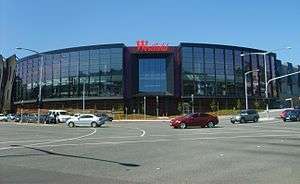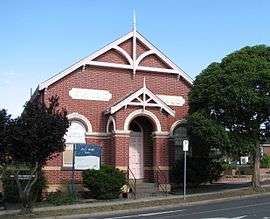Doncaster, Victoria
Doncaster (/ˈdɒnkɑːstə/)[2] is a suburb of Melbourne, Victoria, Australia, 16 km north-east of Melbourne's Central Business District. Its local government area is the City of Manningham. At the 2016 Census, Doncaster had a population of 20,946.[1]
| Doncaster Melbourne, Victoria | |||||||||||||||
|---|---|---|---|---|---|---|---|---|---|---|---|---|---|---|---|
 The exterior of Westfield Doncaster | |||||||||||||||
 Doncaster | |||||||||||||||
| Coordinates | 37.78°S 145.124°E | ||||||||||||||
| Population | 20,946 (2016 census)[1] | ||||||||||||||
| • Density | 2,353/km2 (6,100/sq mi) | ||||||||||||||
| Established | 1860s | ||||||||||||||
| Postcode(s) | 3108 | ||||||||||||||
| Area | 8.9 km2 (3.4 sq mi) | ||||||||||||||
| Location | 16 km (10 mi) from Melbourne | ||||||||||||||
| LGA(s) | City of Manningham | ||||||||||||||
| State electorate(s) | Bulleen | ||||||||||||||
| Federal Division(s) | Menzies | ||||||||||||||
| |||||||||||||||
The suburb, locally known as "Donny", just as its namesake in Great Britain, is situated on 8.9 km2 of land, around the top of the 120 m high Doncaster Hill. The suburb consists of a central area along the top of Doncaster Hill, which includes several historical buildings along Doncaster Road, the Westfield Doncaster Shopping Centre and surrounding high-rise apartments, while the rest of the suburb is typical of many of Melbourne's eastern suburbs, with extensive low-density housing.
In the 12-month period to January 2020 Doncaster reported a median house price of A$1.22 million for a four bedroom house.[3]
Geography
The border of the suburb follows the Koonung Creek from Doncaster Road, along the south of the suburb to Wetherby Road, which, with Victoria Street, forms the eastern border. The northern border follows Ruffey Creek, Williamsons Road, Manningham Road and Ayr Street, to the junction of the Koonung Creek and Doncaster Road.
The suburb is very hilly and due to its location it has panoramic views in every direction with the view to the west through the city stretching out to Bacchus Marsh on a clear day and the Macedon Ranges, to the north the Kinglake Ranges, to the east the Dandenong and Healesville ranges and south across the eastern suburbs to Glen Waverley/Mt Waverley.
Summers are slightly warmer than areas to the south and south west and rainfall is highest in Autumn and Spring on average but during the warmer months some very high totals have been recorded due to its location within the main storm track which moves across the north east quarter of Melbourne.
Mean annual rainfall is approximately 750-780mm and increases from west to east.
It is also a very popular location to view lightning due to its location and elevation.
History

In 1841 Frederic Unwin, a Sydney solicitor, bought 5,120 acres (20.7 km2) of land, including most of the present suburb of Doncaster, from the Crown for one pound an acre under the terms of the short-lived Special Survey regulations. The area was sometimes known as Unwin's Special Survey.
The Doncaster region was settled in the 1860s and 1870s, predominantly by German settler orchardists. The German community was named Waldau,[4] but the name Doncaster gradually became commonly accepted. A Lutheran church was the first one in Doncaster in 1858. A Lutheran school opened in 1860 and a denominational school in 1861.[5] Doncaster Post Office opened on 17 May 1860.[6]
Schramm's Cottage, an historic stone cottage originally located in Doncaster Road (at the site of the fountain next to the Municipal Offices), was relocated to the site of the original Lutheran Church building in Victoria Street in the 1970s. The remains of the Waldau Cemetery, where approximately 150 burials took place between 1853 and 1888, are located in the grounds of Schramm's Cottage.[7]
In the 1880s an observation tower (285 ft high) was constructed on Doncaster Hill, which attracted day-trippers to (what was then) the countryside.
Doncaster was the location of the first electric tram to run in Melbourne in 1889. The tram started in Doncaster and ended in Box Hill (about 3.5 km away). Consequently, this was named "Tram Road". However, the service did not earn any profit, so it ended in 1896 due to feuds with land holders and financial problems.[8] The main road through the suburb, Doncaster Road, was formally named Main Street.
Doncaster remained an orchard area until the 1970s, with the majority of houses built from the 1950s to the 1980s.
In the 1960s and 1970s the suburb was very sought after and many famous builders chose the area along with other similar suburbs like Glen and Mt Waverley to build their project homes with some very modern designs of which several still remain but sadly due to the current redevelopment, some are disappearing.
One good example of modern design and also being of a "cluster housing" project is the Winter Park estate on High St.
In the 1960s and 1970s Doncaster had a very high Australian born population but now has a big Chinese born population and after several years of being a sleepy or rather stagnant in progress, has become a boom suburb for developers as described below.
The Doncaster Hill Recycled Water project is an ambitious project transforming Central Doncaster (Doncaster Hill) into a sustainability hub. The project, being spearheaded by Yarra Valley Water is currently in the process of stakeholder engagement as Yarra Valley Water seeks to understand the needs and values of nearby residents.
Traditional Ownership
The formally recognised Traditional Owners for the area in which Doncaster is located are the Wurundjeri People.[9] The Wurundjeri People are represented by the Wurundjeri Woi Wurrung Cultural Heritage Aboriginal Corporation.[10]
Population
In the 2016 Census, there were 20,946 people in Doncaster. 44.6% of people were born in Australia. The next most common countries of birth were China 15.8%, Malaysia 4.0%, Greece 3.4%, Hong Kong 3.0% and Italy 2.7%. 40.5% of people spoke only English at home. Other languages spoken at home included Mandarin 17.6%, Cantonese 10.1%, Greek 7.8%, Italian 3.6% and Persian 2.5%. The most common responses for religion were No Religion 33.9%, Catholic 17.6% and Eastern Orthodox 10.2%.[1]
Transport
Doncaster was first settled with the first electric tram in the Southern Hemisphere in the late 19th century. Operating from Box Hill to Doncaster (along what is today Tram Road), the tram opened up accessibility to much land in the area. Unfortunately, the line did not last more than a few years.
The major east-west road (Doncaster Road) leads from Kew to Donvale. The Eastern Freeway terminated at Doncaster Road at the western edge of the suburb from 1983 to December 1997.
As a result of a decision by the Victorian Cain Labor Government, the stage 2 section from Bulleen Road to Doncaster Road was only two lanes each way. During this period Doncaster suffered from heavy traffic congestion and air pollution as Doncaster Road carried 60,000 vehicles a day as a major arterial road. Since the Kennett Government extended the Eastern Freeway along the course of the Koonung Creek to Springvale Road, Doncaster's through-traffic has dropped considerably.
Throughout the 1970s the Doncaster line was planned by the State Government to run down the middle of the Eastern Freeway, with land acquired for the line, but was sold in the 1980s.[11] Various plans have also been made for extension of the Route 48 Tram north to Doncaster.[12] Present bus services exist in the area running from a park and ride centre, along dedicated transit lanes to the city.
Doncaster is 3km from Box Hill railway station its closest and has several direct bus routes to the CBD and has three entrances to the Eastern Freeway in both directions and outside of peak times traveling time to the CBD is approximately 15 mins or 10 mins to Collingwood. There are also two orbital SmartBuses (902 and 903) which travels through Doncaster from Airport West to Chelsea and Altona to Mordialloc respectively.
There are bus routes which take you to the CBD along the Eastern Fwy and along Belmore Rd route via Balwyn and Kew and Doncaster Rd through Kew and Collingwood plus routes to Greensborough and Glen Waverley and Box Hill etc
Shopping
In 1969 Westfield Doncaster was built on the corner of Doncaster and Williamsons Roads and is a well-known shopping complex in Melbourne. In the early 1980s and again in the early 1990s, it was renovated and extended. From September 2006 to October 2008, it went through a large revitalisation, improving and enlarging the centre dramatically.[13]
Education
Schools located in Doncaster are:
- Doncaster Secondary College
- Birralee Primary School
- St. Gregory the Great Primary School
- Doncaster Primary School
Sport
The Doncaster Hockey Club was established in October 1974. The council first allowed them to start the club at Timber Ridge Reserve. It was later moved to George Street before being allowed to estabilish a home at Mullum Mullum Reserve where it is today. In 1985 it was the first Australian Club to have a synthetic turf. The club has had 5 Olympians at Doncaster, Chris Ciriello, Russell Ford, Andrew Smith , Lachlan and James Elmer. http://doncasterhockeyclub.com.au/about-us/club-history/
The suburb has an Australian Rules football team, The Doncaster Sharks, competing in the Eastern Football League.[14]
Doncaster Rovers SC is a Doncaster-based Football (soccer) club, currently associated with Football Federation Victoria. The Manningham Cricket Club caters for the area, playing in the Eastern Cricket Association and based at Rieschiecks Reserve, on the corner of Victoria Road and George Street.
The Doncaster Baseball Club was awarded a Diamond Award in 2008 after 10 of the 17 teams it fielded in 2007 made the finals, and three won their premiership titles. In recent years many players from the Dragons (men's 18+ team) have gone on to play for Victoria.
Golfers formerly played at the course of the Eastern Golf Club, on Doncaster Road. The club has since relocated, with the land now being developed into a housing estate.[15]
Government

Prior to 2014, Doncaster formerly had a Victorian State Parliamentary seat named after it, the Electoral district of Doncaster. It is now in the electorate of Bulleen. The current member for Bulleen is Matthew Guy. Doncaster is encompassed within the Federal Seat of Menzies and Kevin Andrews is the local member. At the municipal level, it is located within the City of Manningham.
See also
- City of Doncaster and Templestowe - A former local government area of which Doncaster was a part
- Collyer, Eric (1994) Doncaster: A Short History, Doncaster-Templestowe Historical Society
- Doncaster-Templestowe Historical Society Website
References
- "2016 Census QuickStats Doncaster". Australian Bureau of Statistics. Retrieved 22 September 2018.
- "A definitive guide on how to pronounce Melbourne suburb names". Domain. 6 June 2018. Retrieved 7 June 2018.
- "Real Estate - Properties for Sale, Rent and Share - Domain". www.domain.com.au.
- "German placenames in Australia". www.teachers.ash.org.au. Archived from the original on 11 March 2008. Retrieved 17 March 2008.
- "Doncaster, Victoria (via web.archive.org)". Australian Places Gazetteer. Archived from the original on 19 July 2005. Retrieved 17 March 2008.
- Premier Postal History. "Post Office List". Retrieved 11 April 2008.
- "Schramm's Cottage (via web.archive.org)". Doncaster Templestowe Historical Society. Archived from the original on 3 July 2007. Retrieved 17 March 2008.
- "Box Hill - Doncaster Electric Tramway 1889-1896, Box Hill and Doncaster Victoria - Engineering Heritage Victoria". home.vicnet.net.au. Archived from the original on 16 March 2005. Retrieved 17 March 2008.
- "Map of formally recognised traditional owners". Aboriginal Victoria. Retrieved 2 June 2019.
- "Wurundjeri". Wurundjeri Woi Wurrung Cultural Heritage Aboriginal Corporation. Retrieved 2 June 2019.
- Stephen Cauchi (February 1998). "Whatever Happened to the Proposed Railway to Doncaster East". Newsrail. Australian Railway Historical Society (Victorian Division). 26 (2): 40–44.
- Moynihan, Stephen (18 October 2006). "The Age - 'Rail line would replace 10,000 cars' - October 18, 2006". Melbourne. Retrieved 30 July 2007.
- Westfield Doncaster#Revitilisation
- Full Point Footy. "Doncaster". Archived from the original on 12 June 2010. Retrieved 2008-10-21.
- Golf Select. "Eastern". Retrieved 11 May 2009.
External links
